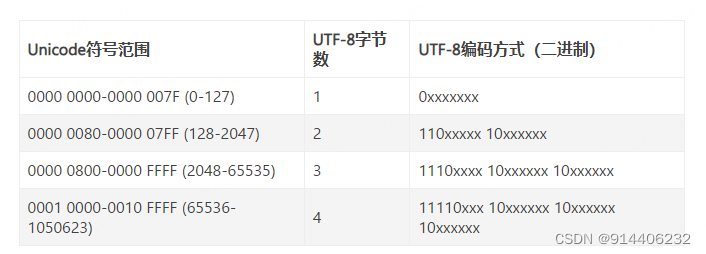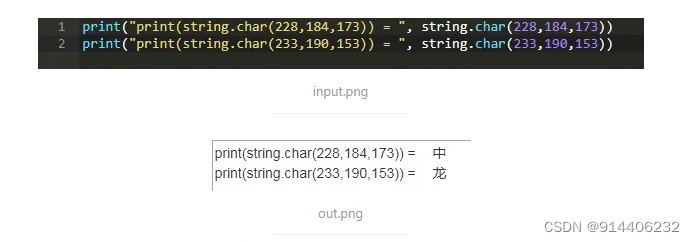一般在工作中会遇到中文字符的判断、截断、打码等需求,之前一直没有总结,虽然网上资料也多,今天在这里简单的总结一下。
1 .UTF-8简单描述
UTF-8 是 Unicode 的实现方式之一,其对应关系(编码规则)如下表所示:

Unicode 可以容纳100多万个符号
UTF-8 最大的一个特点,就是它是一种变长的编码方式。它可以使用1~4个字节表示一个符号,根据不同的符号而变化字节长度。
- 对于单字节的符号,字节的第一位设为0,后面7位为这个符号的 Unicode 码。取值0-127,与标准ASCII 码一一对应。标准ASCII 码表见附录。
- 对于n字节的符号(n > 1),第一个字节的前n位都设为1,第n + 1位设为0,后面字节的前两位一律设为10。剩下的没有提及的二进制位,全部为这个符号的 Unicode 码。
2 .UTF-8的中文字符编码如何生成
例如 将中,龙两个字从Unicode转换为UTF-8:
- 中 : Unicode 是
0x4E2D(0100 1110 0010 1101),根据上表,处于第三行范围内,UTF-8编码需要三个字节,格式为1110xxxx 10xxxxxx 10xxxxxx。
将中的Unicode 二进制填充进这个格式,得到11100100 10111000 10101101,转换为十进制是228,184,173print(string.char(228,184,173))=>中 - 龙 : Unicode 是
0x9F99(1001 1111 1001 1001) ,同样处于第三行范围内。
UTF-8编码为11101001 10111110 10011001(233,190,153)print(string.char(233,190,153))=>龙

3. lua判断字符是不是中文
通常来说,汉字范围从0x4E00到0x9FA5,转换为UTF-8编码为11100100 10111000 10000000(228, 184, 128) 到 11101001 10111110 10100101(233, 190, 165)
因此,中文UTF-8编码用3个字节表示,要遵守格式:1110xxxx 10xxxxxx 10xxxxxx
即第一个字节的取值区间为 [11100000, 11110000) = [0xe0, 0xf0) = [224, 240) 左开右闭
后两个字节的取值区间为[10000000, 10111111] = [0x80,0xbf] = [128, 191] 开区间
4.如何取得字节ASCII码 - string.byte()
- 原型:string.byte (s [, i [, j] ])
- 解释:函数返回字符s[i], s[i+1], ···, s[j]的内部数字编码(ASCII码),其中参数i的默认值是1,而参数j的默认值是i。
5.字符是由几个字节组成
读取第一个字节,在以下区间的代表不同的字节数:
- [
0,0xc0) 表示这个字符仅由1个字节构成 - [
0xc0,0xe0) 表示这个字符由2个字节构成 - [
0xe0,0xf0) 表示这个字符由3个字节构成 - [
0xf0,0xff) 表示这个字符由4个字节构成
-- 判断utf8字符byte长度
-- [0, 0xc0) 表示这个字符仅由1个字节构成 [0,192)
-- [0xc0, 0xe0) 表示这个字符由2个字节构成 [192,224)
-- [0xe0, 0xf0) 表示这个字符由3个字节构成 [224,240)
-- [0xf0, 0xff) 表示这个字符由4个字节构成 [240,255)
function Utils.getChrSize(char)if not char thenreturn 0elseif char >= 240 thenreturn 4elseif char >= 224 thenreturn 3elseif char >= 192 thenreturn 2elseif char >= 0 thenreturn 1end
end6.附加几个常用的函数
我的需求:
-- 把字符串转换成第一个显示后面是**号 如:中国人 -> 中**
function Utils.changeTextExpress(str)if not str then return str endlocal tempStr = ""local len = string.utf8len(str)local first = string.byte(str, 1)local firstLen = sgs.utils.getChrSize(first)tempStr = string.sub(str, 1,firstLen)for i=1,len-1 dotempStr = tempStr .. "*"endreturn tempStr
end再附加几个其他的方法:
-- 计算 UTF8 字符串的长度,每一个中文算一个字符
-- @function [parent=#string] utf8len
-- @param string input 输入字符串
-- @return integer#integer 长度--[[--计算 UTF8 字符串的长度,每一个中文算一个字符~~~ lualocal input = "你好World"
print(string.utf8len(input))
-- 输出 7~~~]]-- end --function string.utf8len(input)local len = string.len(input)local left = lenlocal cnt = 0local arr = {0, 0xc0, 0xe0, 0xf0, 0xf8, 0xfc}while left ~= 0 dolocal tmp = string.byte(input, -left)local i = #arrwhile arr[i] doif tmp >= arr[i] thenleft = left - ibreakendi = i - 1endcnt = cnt + 1endreturn cnt
end-- 计算utf8字符串字符数, 中文按两个字符计算
function stringTool.utf8len_ChineseInTwo( str )local len = 0local currentIndex = 1while currentIndex <= #str dolocal char = string.byte(str, currentIndex)local charLength = stringTool.chsize(char)currentIndex = currentIndex + charLengthif charLength > 2 thenlen = len + 2elselen = len +1end endreturn len
end
--截取字符串,按字符截取
-- str: 要截取的字符串
-- startChar: 开始字符下标,从1开始
-- numChars: 要截取的字符长度
function stringTool.utf8sub( str, startChar, numChars )local startIndex = 1while startChar > 1 dolocal char = string.byte(str, startIndex)startIndex = startIndex + stringTool.chsize(char)startChar = startChar - 1endlocal currentIndex = startIndexwhile numChars > 0 and currentIndex <= #str dolocal char = string.byte(str, currentIndex)currentIndex = currentIndex + stringTool.chsize(char)numChars = numChars -1endreturn str:sub(startIndex, currentIndex - 1), numChars
end




![练[SUCTF 2019]CheckIn](http://pic.xiahunao.cn/练[SUCTF 2019]CheckIn)








的区别)
)



